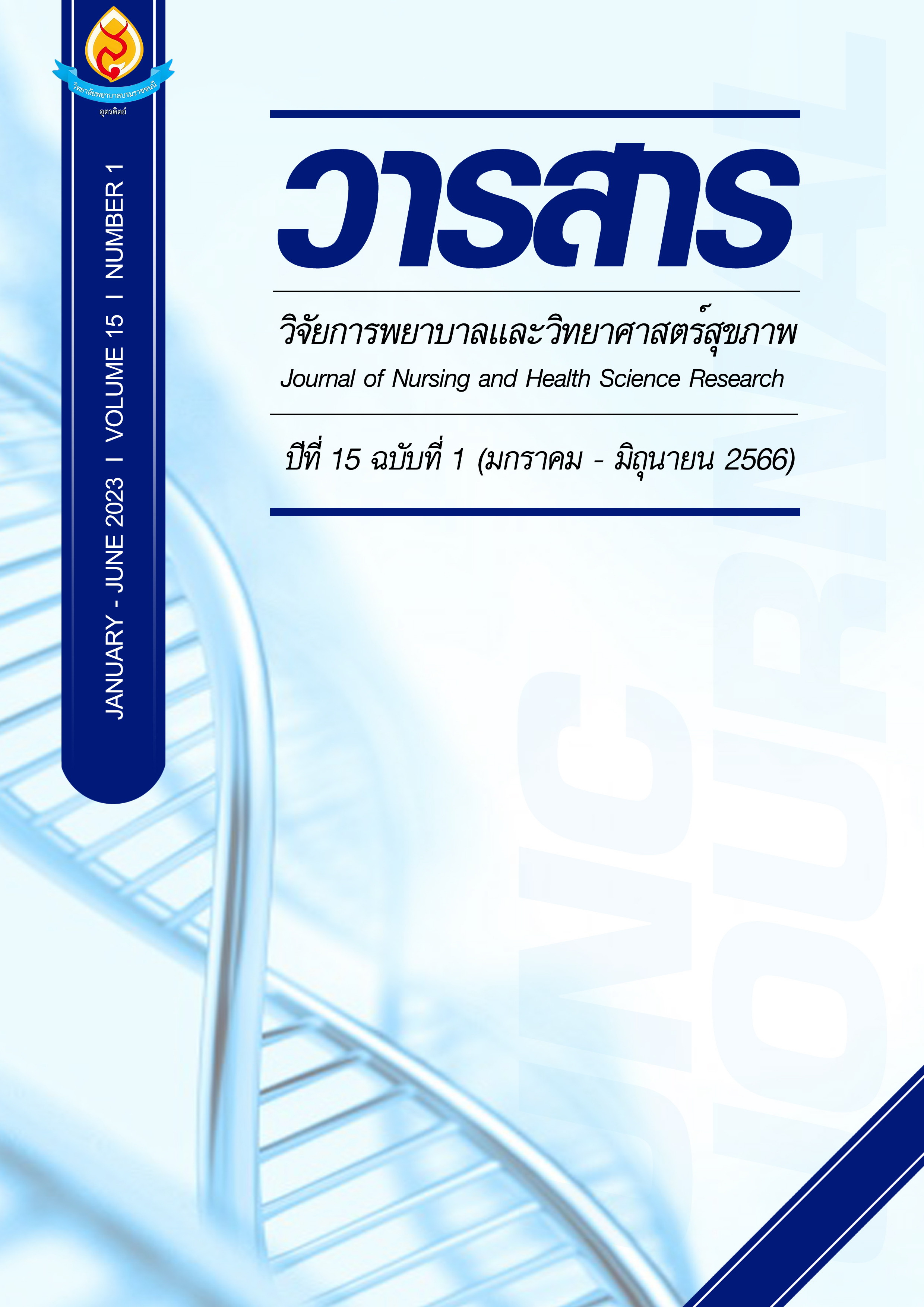โปรแกรมการป้องกันกลิ่นเท้าโดยการประยุกต์ใช้แบบแผนความเชื่อด้านสุขภาพและ แรงสนับสนุนทางสังคมของทหารกองประจำการ สังกัดมณฑลทหารบกที่ 35 จังหวัดอุตรดิตถ์
Main Article Content
บทคัดย่อ
การวิจัยครั้งนี้มีวัตถุประสงค์เพื่อศึกษาผลของโปรแกรมการป้องกันกลิ่นเท้าโดยประยุกต์ใช้แบบแผนความเชื่อด้านสุขภาพและแรงสนับสนุนทางสังคม กลุ่มตัวอย่างเป็นทหารกองประจำการ มณฑลทหารบกที่ 35 จังหวัดอุตรดิตถ์ จำนวน 60 คน แบ่งเป็นกลุ่มทดลองและกลุ่มควบคุม กลุ่มละ 30 คน ระยะเวลาในการทดลอง 8 สัปดาห์ เครื่องมือที่ใช้ในการวิจัย ได้แก่ โปรแกรมการป้องกันกลิ่นเท้า แบบประเมิน แบบบันทึกและแบบสอบถาม สถิติที่ใช้ในการวิเคราะห์ข้อมูล ได้แก่ ความถี่ ร้อยละ ค่าเฉลี่ย ส่วนเบี่ยงเบนมาตรฐาน และการทดสอบที
ผลการวิจัยพบว่า 1) กลุ่มทดลองมีคะแนนเฉลี่ยความรู้เกี่ยวกับกลิ่นเท้า การรับรู้ตามแบบแผนความเชื่อด้านสุขภาพ แรงสนับสนุนทางสังคม และพฤติกรรมการป้องกันกลิ่นเท้าหลังการทดลองสูงกว่าก่อนทดลอง อย่างมีนัยสำคัญทางสถิติที่ระดับ .05 2) กลุ่มทดลองมีคะแนนเฉลี่ยความรู้เกี่ยวกับกลิ่นเท้า การรับรู้ตามแบบแผนความเชื่อด้านสุขภาพ แรงสนับสนุนทางสังคม และพฤติกรรมการป้องกันกลิ่นเท้า สูงกว่ากลุ่มควบคุมอย่างมีนัยสำคัญทางสถิติที่ระดับ .05 3) กลุ่มทดลองมีเชื้อแบคทีเรียที่เท้าลดลงมากกว่าก่อนทดลอง ร้อยละ 50.00 4) กลุ่มทดลองมีความพึงพอใจหลังได้รับโปรแกรมฯ อยู่ในระดับมากที่สุด แสดงให้เห็นถึงโปรแกรมการป้องกันกลิ่นเท้าสามารถเพิ่มความรู้และเปลี่ยนแปลงพฤติกรรมเพื่อการป้องกันกลิ่นเท้าได้อย่างมีประสิทธิภาพ
Article Details

อนุญาตภายใต้เงื่อนไข Creative Commons Attribution-NonCommercial-NoDerivatives 4.0 International License.
บทความหรือข้อคิดเห็นใดใดที่ปรากฏในวารสารวิจัยการพยาบาลและวิทยาศาสตร์สุขภาพ เป็นวรรณกรรมของผู้เขียน ซึ่งบรรณาธิการหรือสมาคมศิษย์เก่า ไม่จำเป็นต้องเห็นด้วย และบทความที่ได้รับการตีพิมพ์เผยแพร่ถือเป็นลิขสิทธิ์ของวารสารวิจัยการพยาบาลและวิทยาศาสตร์สุขภาพ
เอกสารอ้างอิง
Ampankao, U., Vorapongsathorn, S., Wattanaburanon, A. & Chooratna, K. (2021). Effects of health education program applying self regulation on foot care behavior change of diabetes type 2 patients in public health center 15 Ladprao, department of health, Bangkok. Journal of health, physical education and recreation, 48, 260-271. (in Thai).
Ara, K. et al. (2006). Foot odor due to microbial metabolism and its control. Canadian Journal of Microbiology, 52(4), 357-364.
Becker, M. H. & Maiman, L. A. (1975). Sociobehavioral determinants of compliance with health and medical Care Recommendations. Medical Care, 13, 10-24.
Best, J.W. (1978). Research in education. New Delhi: Prentice hall of India Inc.
Bubnis, D. (2017). Ten ways to get rid of smelly feet. Retrieved (2021, Fabruary 27). from https://www.medicalnewstoday.com/articles/319002.
Bloom, B.S. (1971). Handbook on formative and summative evaluation of student learning. New York: Mcgraw-Hill.
Charan, J. & Biswas, T. (2013). How to calculate sample size for different study designs in medical research?. Indian journal of Psychological Medicine, 35(2), 121-126.
Cunha, M. (2021). Dealing with stinky feet. Retrieved (2021, Fabruary 14). fromhttps://www.gothamfootcare.com/blog/stinky-feet.
Fort Pichaidaphak hospital. (2020). Summary of survay results Health Behaviors and problems encountered from wearing shoes in military uniforms, 35th Military Circle, Uttaradit Province. Uttaradit: Administrative department, Fort Pichaidaphak hospital. (in Thai).
Hoque, T. (2017). An update of pitted keratolysis: a review journal of current and advance Medical Research. Journal of Current and Advance Medical Research, 4(1), 27-30.
House, J.S. (1981). Work, stress and social support. MA:Addison-Wesley.
Jirawatkul, A. (2008). Biostatistics for health science research. Khon Kaen: Khon Kaen University. (in Thai).
Kongburan, P. (2008). Factors affectting on adjustment of new privates of the third infantry battalion of the first infantry division of the king’s own bodyguard, Bangkok. (master’s thesis). Srinakharinwirot University. (in Thai).
Petchpoom, J. (2017). Health behaviors, concepts, theories and applications. Phitsanulok: Naresuan University. (in Thai).
Royal Thai Government Gazette. (1999). Ministerial regulation 1999, Army uniforms issue 80. Retrieved (2021, Fabruary 27). from https://www.ratchakitcha.soc.go.th/DATA/PDF/2542/A/113/6.PDF. (in Thai).
Seangpraw, K. (2018). Heallth education and Health behavior. Bangkok: Chulalongkorn University. (in Thai).
Spitz, M.G. & Arcidiacono S.M. (2016). Defining antimicrobial textile requirement for military applications-a gap analysis. U.S. army natick soldier research. Development and Engineering Center Natick, Massachusetts.
Sulluvan, D. (2017). How to get rid of smelly feet (Bromodosis). Retrieved (2021, Fabruary 27). from https://www.healthline.com/health/how-to-get-rid-of-smelly-feet#takeaway.
Thongboon, K. (2002). Factors affecting the health promotion behaviors in privates in army aircraft maintenance battalion, Lopburi Province. (master’s thesis). Kasetsart University. (in Thai).
Wulandari, N. F., SUharna, N., Yulinery, T. & Nurhidayat, N. (2020). Preliminary study on bacterial diversity causing human foot odor. IOP Conference Series: Earth and Environmental Science, 439, 1-9.


